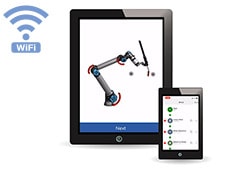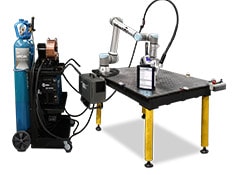Automated Welding is the future of the welding industry. It is one of the most important factors impacting the welding industry in the coming years. We will see more changes in the next decade compared to the last 100 years. Automated welding awareness has risen which has encouraged many industrialists to introduce automated welding equipment in their manufacturing process. Things like collaborative technology and fixtureless welding are expected to join the welding industry in the coming few years. Let’s check out some of the technology advancements that will be on the welding floor in the coming years.
1. Production Monitoring by Implementing Cloud-Based Technology
Production Monitoring Systems are a priority for manufacturers nowadays. These systems are good at tracking each welder and can be very effective in maintaining consistency. These monitoring systems are capable of detecting any red flag welding issue in the production line and can track the activities for futre prevention. Unlike the past, these systems are now designed for recording various quality assessments and not just maintaining the production metrics. This can save a huge amount of time on the production line which benefits the whole production process.
Cloud-Based Monitoring Systems are advantageous over the old fashioned VPN platform. If a company has multiple manufacturing locations, then Cloud-Based monitoring systems can provide live data which can be accessed from anywhere. Mobile ready apps for monitoring the production line give an added advantage to the process. In the end, there is no need for IT manpower at every location as maintenance is carried out at the main server automatically.
2. Shortage of Labour
According to research conducted by the American Welding Society, there will be a shortage of approx. 2, 00,000 welders in the U.S by 2020. This can be the point of an argument. When there is an opportunity for automated welding, then what is the need for manual welding labor?
There are some conditions where robots are not capable of doing what a human can do. For example, there are some situations where welding skills are needed that automated welding equipment can't perform. In these cases, technically skilled welders are needed. In the upcoming years, demand for trained technicians will increase to maintain the new automated welding apparatus.
3. Robot and Human Collaboration Technology
A Collaborative Robotic Welding System - Robotics industries are working on a collective technology between humans and robots for a safe welding procedure. Movement-based programming is currently in the development process and can play a crucial role in welder safety. Robots can recognize commands and will be able to generate a program. The hand movement will be used to provide direction, angle, size, etc. and this can prove an instinctive tool in the welding industry.
The demand for Cobots has been rising for the last half-decade. Cobots are easy to operate and results in greater flexibility in the Human Environment. Cobots can provide a tailored solution to meet the requirements of the manufacturers.
4. Welding Safety
The safety of welders is always the first concern for every welding industry. Safety innovations have been implemented to provide a safer environment for labor. With the government putting on strict laws and rules, companies are taking safety precautions to protect their workers. The ultra-fine dust particles are causing damage to the respiratory systems of the welders. Keeping this in mind, companies are investing in respiratory protection equipment as it is the most effective way of keeping their welders from getting sick.
5. Fixtureless Welding
Fixtureless welding can be a solution for special fixture welding issues. By combining both handling robots and welding robots, there is no need for an operator to work on the dedicated fixtures used in the old welding process. This can be beneficial in increased productivity and improved quality. The maintenance of the fixtureless welding is also less as compared to ordinary welding.
6. GTAW and Laser Beam Welding
Engineers speculate about which welding process will see a rise in the coming times. According to the American Welding Society, the GTAW welding system will boom due to its high-quality yield on thin materials. It will increase along with the automation. Professionals at AWS also mentioned that any automated process will be in more use as compared to others in the welding industry.
Another future technology in the welding industry will be Laser Beam Welding. The laser beam welding process will be targeted for expanded use. A few years ago, only thin material was welded by laser welding but with advanced technology, it has changed significantly. Prominent alloys materials like copper and aluminium can be easily welded with laser technology, unlike the conventional CO2 lasers.
In today’s scenario when the economy is at downfall, every manufacturer wants to stay at a profitable side. The declining skilled workforce compels the welding industry to make use of the automated welding equipment and with this increasing demand, technology will play its crucial role in defining the future of the Welding Industry.













0 comments:
Post a Comment